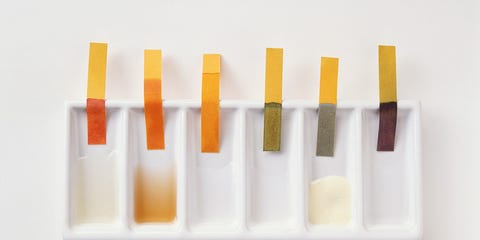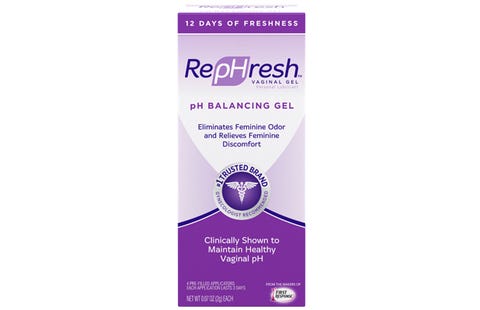How Do You Find the Ph of an Aqueous Solution

Dorling Kindersley/Getty Images
If you've visited the "feminine hygiene" aisle at a drugstore lately, you've probably noticed that maxi pads and tampons aren't the only items lining the shelves. A slew of special cleansers, gels, and creams for your lady parts have cropped up in recent years, with several promising to help you get your pH in balance. But what the heck is vaginal pH—and should you even care?(Looking to take back control of your health? Prevention magazine has smart answers—get 2 FREE gifts when you subscribe today.)
As you may or may not remember from high school science class, pH is a number that tells you how acidic something is on a scale of 0 (acid) to 14 (base). And, believe it or not, your vagina really does have an optimal pH. If it's out of whack, you can develop odor, irritation, and even an infection.
MORE:8 Reasons It Hurts During Sex—And How To Fix It
"Every single part of the body has a normal 'environment,' " says Lauren Streicher, MD, a clinical associate professor of obstetrics and gynecology at Northwestern University's Feinberg School of Medicine in Chicago. The vagina's normal pH is somewhere between a 3.5 and a 4.5, she says, which allows for a healthy balance of "good" and "bad" bacteria. The good guys are lactobacilli, bacteria that give off lactic acid, which in turn keeps vaginal pH low.
When pH is normal, "it's an indication that the lactobacilli are doing their thing," Streicher says. The result: normal discharge, lubrication, and no irritation or funky smells. But every once in a while, something tips the scales. The change makes the vagina a less hospitable environment for lactobacilli and a more welcoming place for bad bacteria instead. The bad guys can cause odor and irritation and, in the worst-case scenario, set the stage for bacterial vaginosis (BV), the most common vaginal infection in women ages 15 to 44. (Here's what your vaginal discharge means.)
A number of things can interfere with vaginal pH. Blood has a pH of 7.4 and semen has a pH in the neighborhood of 7 or 8, so vaginal pH may change after your period or sex. It typically returns to normal soon after, but sometimes it stays elevated longer than it should.
MORE:5 Reasons It Hurts Down There
Menopause messes with pH, too: When women stop producing estrogen, many experience vaginal dryness and thinning, which ends up killing off lactobacilli and causing pH to rise. In fact, postmenopausal women often have a pH in the range of 5 to 6, which is slightly higher than ideal, says JoAnn V. Pinkerton, MD, executive director of the North American Menopause Society and a professor of obstetrics and gynecology at the University of Virginia Health Center. Irritation and odor are common problems.
So what about those over-the-counter products that offer to set your pH straight? Do they really work? Surprisingly, the experts say yes: Unlike douching or using down-there perfumes, products designed to balance pH might actually have a place in your vaginal care routine. They've just got to be the right ones—usually gels or creams that go inside the vagina. Special washes that you use externally are basically worthless, since they affect only the vulva.

RepHresh/Facebook
If you're someone who often notices odor or irritation after menstruation or intercourse, then using something like RepHresh pH Balancing Gel after your period or sex might help, says Streicher. (If it doesn't, see your doctor to see what else might be going on.) Postmenopausal? A pH-balancing moisturizer that you put in the vagina may provide relief from dryness and rebalance pH at the same time, Pinkerton says. Just don't expect miracles: "There are limits to the benefits of vaginal pH products because they don't improve the number of thick vaginal cells or improve elasticity," says Pinkerton. "Vaginal estrogen can replace what's missing if symptoms persist."
Sarah Klein Sarah Klein is a Boston-based writer, editor, and personal trainer currently with LIVESTRONG.com, and previously of Health.com, Prevention magazine, and The Huffington Post.
This content is created and maintained by a third party, and imported onto this page to help users provide their email addresses. You may be able to find more information about this and similar content at piano.io
How Do You Find the Ph of an Aqueous Solution
Source: https://www.prevention.com/health/a20514037/whats-a-vaginal-ph-wash-and-do-you-really-need-one/

0 Response to "How Do You Find the Ph of an Aqueous Solution"
Post a Comment